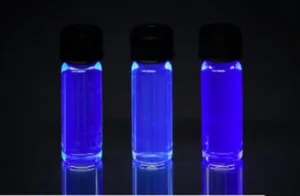A team of researchers headed by Hyung Suk Kim of the School of Electrical Engineering at the Korea Advanced Institute of Science and Technology or KAIST (Daejeon, Republic of Korea) are developing new TADF-based OLED deep blue emitter molecules that achieve high external quantum efficiency.
A few words of background information.
TADF stands for thermally activated delayed fluorescence. TADF is a process through which a molecular species in a non-emitting excited state can incorporate surrounding thermal energy to change states and only then undergo light emission. The mechanism by which this is accomplished in a TADF material is through the harvesting of triplet state electrons to generate fluorescence. This is good news for the commercial prospects of developing a suitable TADF-based OLED because TDAF materials can have an abundance of triplet states. Unfortunately, the means by which TADF achieves an abundance of triplet states is by doping the material with an environmentally unfriendly heavy metal. More unfortunately, it is very difficult to create a stable blue OLED using this approach. Addressing these issues were the focus of the research undertaken by the team.
A recent article on this topic by the team is entitled “Toward highly efficient deep-blue OLEDs: Tailoring the multiresonance-induced TADF molecules for suppressed excimer formation and near-unity horizontal dipole ratio.” It was published in Sci. Adv. 9, eadf1388 (2023) 31 May 2023.
The details by which the new molecules were designed, synthesized and tested are explained in this article and are somewhat technical. Paraphrasing the article, the researchers explain that the starting point for their new approach was the fact that boron-based compounds can exhibit multiresonance TADF and that these compounds have been used as the basis for blue light emitting OLEDs. Such displays demonstrated high efficiency and a wide color gamut. Also demonstrated was that the planar nature of these materials made them prone to concentration induced excimer formation that broadens the emission spectrum, making it hard to increase the emitter concentration without raising the CIE y coordinate.
Starting with this understanding, the task for the researchers in developing a suitable material had become addressing issues associated with the planarity of boron-based compounds. The means by which this was accomplished was the development of a new emitter material that utilized sterically hindered peripheral phenyl groups in the boron-based TADF emitter. (Note that steric hindrance is defined as: the higher energy price and slower reaction rate due to the approach of larger atoms or groups in a chemical reaction, compared to a similar reaction involving smaller atoms or groups.) Steric hindrance was used to reduce intermolecular interactions, leading to excimer formation and, thus, making the pure narrowband emission character far less sensitive to concentration.
The resulting material, designated o-Tol-ν-DABNA-Me, was found to produce a pure narrowband emission that was far less sensitive to concentration compared to standard TADF emitters. The figure below illustrates the o-Tol-ν-DABNA-Me molecule developed by the research team.

With this approach, the researchers demonstrated a deep blue OLED with a CIE y of 0.12, a full width at half maximum of 18 nm and a maximum external quantum efficiency of about 33%. Adopting a hyperfluorescent architecture, the OLED performance was further enhanced to an external quantum efficiency of 35.4%. In addition it was found that the roll off in efficiency had been reduced.
The researchers conclude their article with the assessment that they have illustrated the “immense potential of the proposed method for energy efficient deep blue OLEDs.”
Reference
Kim, H. S., Cheon, H. J., Lee, D., Lee, W., Kim, J., Kim, Y.-H., & Yoo, S. (2023). Toward highly efficient deep-blue OLEDs: Tailoring the multiresonance-induced TADF molecules for suppressed excimer formation and near-unity horizontal dipole ratio. In Science Advances (Vol. 9, Issue 22, p. eadf1388). https://www.science.org/doi/abs/10.1126/sciadv.adf1388

